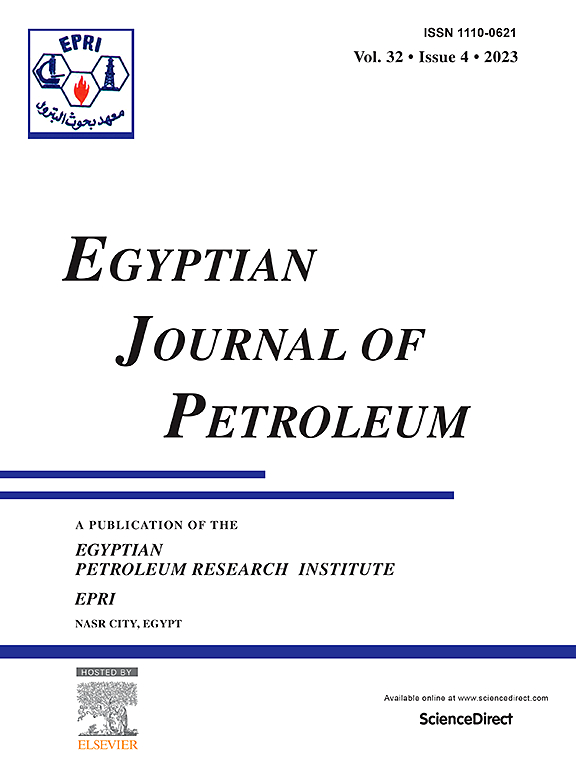Determination of Shale Types and their Volumes and Petrophysical Exponents for more Accurate Water Saturation Estimation for Raha Formation, Gulf of Suez, Egypt
Q1 Earth and Planetary Sciences
引用次数: 0
Abstract
This study depends on the analysis of well logging data for the Raha Formation, utilizing eight wells scattered in the Ras Budran Oil Field. It is situated in the northern region of the Gulf of Suez ' s Belayim Offshore Oil Field and is 4 km away from the Sinai coast. Water saturation is one of the steps through which the characterization of the reservoir and prediction of future accumulation are determined. Many parameters, such as types of shale, volumes of each type, and petrophysical exponents, are necessary to detect the accurate estimation of water saturation. First, Dia-Porosity crossplots are used to estimate three types of shale and their volumes (dispersed, laminated, and structural). From these plots, it was found that the dispersed shale exhibits the highest percentage in the middle of the study area, while the laminated shale volume increases toward the north directions, but the structural shales give the maximum value in the north-west trend. The presence of scattered shale in a formation is known to have a negative impact on the permeability of the rock, unlike the laminated shale, which decreases the total average of effective porosity. Comparable to laminated shale, structural shale has nearly identical characteristics. Second, the petrophysical exponents (cementation factor ( m ), saturation exponent ( n ), and tortuosity factor ( a ) were ascertained using Pickett ' s plot. It gave the values of m ranging from 1.8 to 2.3 and values of a varying from 0.72 to 1 in the studied wells, where these petrophysical exponents play a vital role for calculating the water saturation (Sw) in both clean and shaly rocks. This study aimed to determine the different types of shale and calculate the petrophysical exponents, which are important for a good estimation of the water saturation in rocks (clean and/or shaly) and for determining hydrocarbon saturation (Sh)确定页岩类型及其体积和岩石物理指数,以便更准确地估算埃及苏伊士湾拉哈地层的含水饱和度
本研究利用分布在拉斯布德兰油田的八口油井,对拉哈地层的测井数据进行分析。该油田位于苏伊士湾贝拉伊姆海上油田北部地区,距离西奈海岸 4 公里。含水饱和度是确定储层特征和预测未来储量的步骤之一。许多参数,如页岩类型、每种类型的体积和岩石物理指数,都是准确估算含水饱和度的必要条件。首先,使用 Dia-Porosity 交叉图估算三种页岩类型及其体积(分散页岩、层状页岩和结构页岩)。从这些图中可以发现,分散页岩在研究区域的中部所占比例最高,层状页岩的体积向北增加,而结构页岩则在西北方向给出了最大值。众所周知,地层中分散页岩的存在会对岩石的渗透性产生负面影响,而层状页岩则不同,它会降低有效孔隙度的总平均值。与层状页岩相比,结构页岩具有几乎相同的特征。其次,利用皮克特曲线图确定了岩石物理指数(胶结系数(m)、饱和指数(n)和曲折系数(a))。在所研究的油井中,m 的值从 1.8 到 2.3 不等,a 的值从 0.72 到 1 不等,这些岩石物理指数对计算清洁岩石和页岩的含水饱和度(Sw)起着至关重要的作用。这项研究旨在确定不同类型的页岩并计算岩石物理指数,这对正确估算岩石(清洁和/或有页岩)中的含水饱和度以及确定碳氢化合物饱和度(Sh)非常重要。
本文章由计算机程序翻译,如有差异,请以英文原文为准。
求助全文
约1分钟内获得全文
求助全文
来源期刊

Egyptian Journal of Petroleum
Earth and Planetary Sciences-Geochemistry and Petrology
CiteScore
7.70
自引率
0.00%
发文量
29
审稿时长
84 days
期刊介绍:
Egyptian Journal of Petroleum is addressed to the fields of crude oil, natural gas, energy and related subjects. Its objective is to serve as a forum for research and development covering the following areas: • Sedimentation and petroleum exploration. • Production. • Analysis and testing. • Chemistry and technology of petroleum and natural gas. • Refining and processing. • Catalysis. • Applications and petrochemicals. It also publishes original research papers and reviews in areas relating to synthetic fuels and lubricants - pollution - corrosion - alternate sources of energy - gasification, liquefaction and geology of coal - tar sands and oil shale - biomass as a source of renewable energy. To meet with these requirements the Egyptian Journal of Petroleum welcomes manuscripts and review papers reporting on the state-of-the-art in the aforementioned topics. The Egyptian Journal of Petroleum is also willing to publish the proceedings of petroleum and energy related conferences in a single volume form.
 求助内容:
求助内容: 应助结果提醒方式:
应助结果提醒方式:


